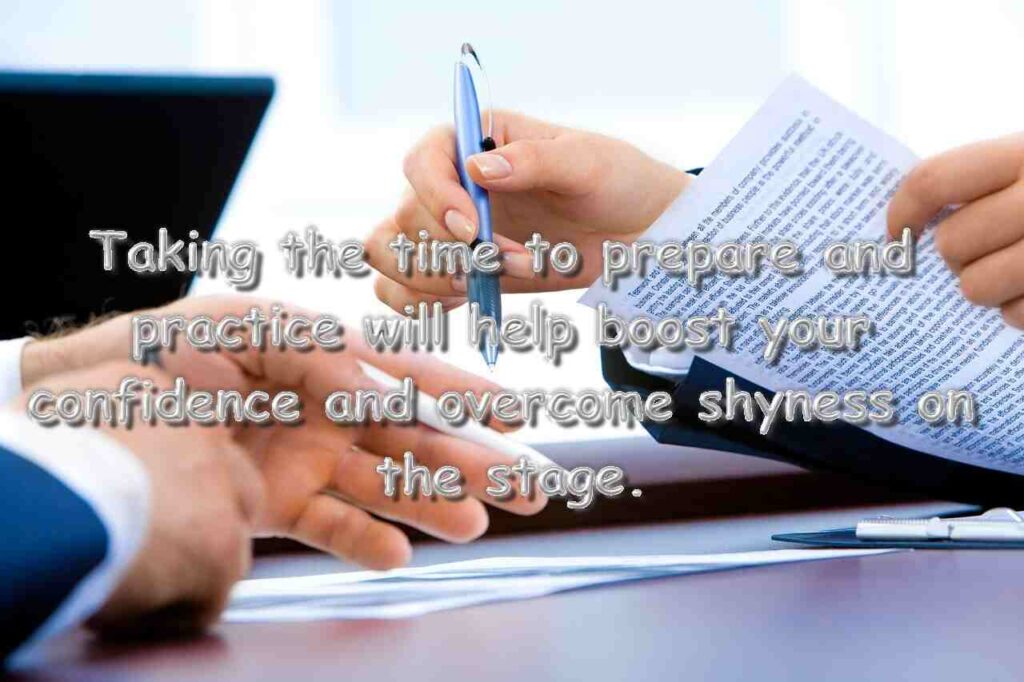If you are wondering for how to overcome shyness in public speaking then have a look at the following things. Are they seem familiar to you…?
“I dislike being observed by others, taking the stage in front of others, speaking in front of a large audience, and speaking in front of a crowd that is paying attention to me out of fear.”
Or you may experiencing another group of things in your life;
“Worried about what people will think, Worried that the audience won’t be interested in what I have to say, Worried that they’ll laugh at me.”
Or you may have Stress-related physical symptoms in your life;
“My palms start to perspire, my mouth feels dry, and the emotional experience is so intense that it seems to make me cry. I also start to go pale when I speak.”
“Feeling of Shyness”
Shyness is a feeling of insecurity, lack of confidence, and discomfort around others. It is a common emotion, experienced by most people at some point in their lives.
For some people, shyness can be debilitating and can prevent them from participating in social activities, such as speaking in public. However, with the right techniques, it is possible to overcome shyness and become a confident public speaker.
Physical indicators;
Shyness can manifest itself in the form of physical symptoms, such as
“I feel anxious, as seen by my shaking hands and speech impediment.”
“Panic attack that would prevent me from conversing”.
“I’m turning red/blushing”
Physically, shyness can make it difficult to speak up, make it hard to concentrate, and can make it harder to remember things.
mental indicators;
It may also result in mental indicators such as;
“I keep making mistakes.”
“I frequently forget to mention things that I need to.”
“I’m going to mess up even more because I’m forgetting what I’m supposed to say,”
“Appearing as though I don’t understand what I’m talking about.”
These are my key concerns or phobias.
Great skill for Great people;
Public speaking is an important skill to have in order to succeed in many professions. Being able to confidently speak in front of a group can help to get your message across, impress your colleagues, and build relationships. It can also be a great way to boost your self-confidence and make a good impression.
Shyness can be a difficult emotion to overcome, but;
With practice and the right techniques, it is possible to become a confident public speaker. By practicing, focusing on your strengths, and using positive self-talk, you can build your self-confidence and become a great public speaker.
At the end of this article you will be able to identify the symptoms of your shyness, finding the causes and taking the Appropriate steps to Overcome.
16 simple strategies for “How to overcome shyness in public speaking”
Let’s discuss one by one.
1: Understand Your Fears

When it comes how to overcome shyness in public speaking, Honestly speaking, the fear of public speaking can be paralyzing.
Root causes of this fear:
There are many root causes of this fear, and understanding these root causes can help you to address the fear and become a better and more confident public speaker.
First
Fear of being judged i.e. “I worry that I won’t be able to measure up to my peers”
Alternatively, “That people will harshly evaluate me for my mistakes.”
This type of fear is often linked to perfectionism, and can lead to a fear of failure.
Second
Some people may have had past experiences of public speaking that have caused them to be fearful in the present. This could include a fear of public humiliation, or fear of being laughed at.
Third
You may be afraid of the unknown. You don’t know what to expect when you give a speech, and you may be afraid of making a mistake or going off topic.
Fourth
Lack of confidence leads to fear of public speaking.
Fifth
Fear of the spotlight is a root cause of fear of public speaking. If you are uncomfortable with the attention of the crowd, you may be afraid to take the stage.
Sixth
Fear of being incorrect i.e. “I’m afraid of getting in trouble if I say or do something stupid.”
If you can identify the causes of your fear, you can take steps to address them and to stop them making you shy.
2: Prepare Thoroughly Before Speaking:

1. Know Your Material:
Take the time to become familiar with the content of your speech or presentation. Research the topic and practice talking about it out loud. If there are visuals, such as slides or handouts, make sure you understand how to use them and practice with them.
2. Know Your Audience:
Gather information about the people who will be attending your speech or presentation. What is their age, educational level, and background? Knowing this will help you tailor your message to the interests and needs of the audience.
3. Practice, practice, practice!
Practice speaking in front of a mirror or with family and friends. Pay attention to your body language, pacing, and hand gestures. Record yourself and then watch the video to identify areas for improvement.
By following these steps, you can make sure you are prepared for your public speaking engagement. Taking the time to prepare and practice will help boost your confidence and ensure that your speech or presentation is successful.
3: Visualize Yourself Speaking Successfully

With a little bit of imagination, you can create a vivid and realistic scenario that will help you to feel more confident and comfortable when you take the stage.
Go on step by step;
- Start by finding a quiet place and closing your eyes
- Visualize the physical space around you
- Notice the size and shape of the room, the lights, the people, and the stage
- Imagine yourself walking up to the podium with a sense of purpose, looking out into the audience and connecting with them
- Feel the energy of the room and the anticipation of the crowd
- Hear the sound of your own voice as you speak with clarity, confidence, and passion
- Notice the feeling of calmness that comes from knowing that you have the knowledge and tools to successfully deliver your message
- Feel the warmth of the audience’s response as they connect with you and your message
- Finally, open your eyes and take a few deep breaths, knowing that you have just visualized yourself successfully speaking on stage in front of an audience
5. Practice, Practice, Practice
Before you even think about speaking in front of an audience, you should prepare thoroughly and practice what you plan to say.
Make sure you have followed the following things;
- practice your speech out loud
- focus on the pronunciation of words, as well as the speed and volume of your voice
- think carefully about the structure of your speech and the transitions between points
- Rehearsing your speech in front of a small group of people, such as friends and family
- Finally, make sure you practice the body language that you will use when you are on stage, such as maintaining good posture and using hand gestures effectively.
All of this practice is to make sure that you feel confident and at ease when speaking in front of an audience.
5: Build Self-Confidence with Positive Affirmations
Positive affirmations are short, positive statements that can help to boost your mood and self-esteem.
Positive affirmations can be tailored to each individual, but some examples include:
- “I am capable of achieving great things”
- “I have something valuable to contribute”
- “I have the ability to change things”
Before speaking, take a few moments to practice some positive affirmations. Recite them out loud or silently to yourself and let the power of the words sink in.
- Think of a few moments in your life where you have achieved something significant
- Remind yourself that you are capable of greatness
- Remind yourself it is normal and natural to feel this way
Remember that everyone experiences fear and anxiety before speaking in front of an audience. The key is to acknowledge the fear, but to not be consumed by it.
6: Make Eye Contact

Making eye contact shows your audience that you are confident and engaged in your presentation. It also helps to keep the audience focused and attentive to what you are saying.
When making eye contact, try 7 things;
- look at different parts of the audience
- Don’t just stare at one person or group
- Move your eyes around the room
- Make sure to maintain eye contact with everyone
- Remember to keep your eyes open and direct your gaze around the room
- Avoid darting your eyes around as this can make you appear nervous and unconfident
- try to limit your movement and focus on the person you are speaking to for a few seconds
This will help your audience to feel heard and respected and you feel more confident and less shy.
7: Take Deep Breaths and Relax

Public speaking can be very intimidating and nerve-wracking.
Before any speech or presentation, it is important to take a moment to relax and de-stress. Taking a few deep breaths can help you to calm your nerves and focus on the task at hand.
Before you stand in front of your audience;
- take time to collect your thoughts
- practice your speech beforehand
- it is important to remember that most people are supportive and want you to do well
- Don’t focus on the possibility of failure or embarrassment
- Instead, concentrate on the positive aspects of the circumstance.
- Lastly, try to enjoy yourself!
With a little preparation and relaxation, you can make your speech a success.
8: Focus on Your Audience

The key to overcoming shyness is to focus on your audience not on yourself. When you are preparing to give a presentation;
- Consider the people you will be speaking to and what they want to hear.
- Do some research on the audience, such as their age, gender, profession, interests, and what they already know about the topic
- Pay attention to your audience’s reactions and adjust your approach accordingly.
- If they seem confused, slow down and explain the concept more clearly
- If they seem bored, switch up the pace or change the topic.
Ultimately, by taking the time to understand and engage with your audience, you can create a successful presentation without shyness that will leave a lasting impression.
9: Don’t Rush

Your heart may be racing and your palms may be sweaty, but it is important to take a deep breath and remember to not rush.
When you rush through a speech;
- You often don’t give yourself enough time to really get your point across
- The audience will not understand the context of the speech
- You may not be able to articulate your points properly
- You may miss words or stutter
- The audience may not be able to follow your train of thought.
Therefore, it is important to speak slowly and deliberately when giving a speech. Slow and steady wins the race when it comes to public speaking, so remember to take your time and not rush.
10: Be Yourself

You may feel that you don’t have the confidence or the right words to express yourself.
Here are some tips to help you be yourself while speaking in public:
1. Be comfortable in your own skin. Stop trying to be someone you are not.
2. Speak from the heart. Your words will be more meaningful if they come from an authentic place.
3. Make sure that you are prepared for any questions that may come up.
4. Make sure that you make eye contact and use your body language to engage with your audience.
5. Be natural. Don’t try to overdo it or be too rehearsed.
6. Be happy with yourself.
Being yourself while speaking in public can be a challenge, but if you follow these tips, you can ensure that you will be able to deliver a strong and impactful presentation.
5 techniques to Engage with your audience?
Here are five techniques to engage with your audience:
1. Establish eye contact.
2. Humor is a great way to engage with your audience. People often remember humorous moments.
3. Asking questions is a great way to keep your audience engaged.
4. Using visuals can help to illustrate your points and to break up a monotonous presentation.
5. Inviting audience participation is an excellent way to engage with your audience.
11: Don’t lose Confidence

But how? Yes, I know it’s not easy but still you can feel more confident.
Do one thing, “Pretend yourself to be more confident over and over again” whether you like it or not.
A lie told over and over again seems to be the truth.
It’s easy to feel overwhelmed by the thought of standing up in front of a crowd and speaking.
Follow these 5 simple strategies,
- Spend some time before your presentation researching the topic
- List the key topics you want to address.
- Practice in front of a mirror or a friend to observe your body language, tone, and delivery.
- Remember to speak slowly and clearly
- Finally, be aware of your body language and be sure to smile.
12: Smile and Show Enthusiasm
A smile and enthusiasm can have a profound impact on a presentation, making it much more effective.
You can have following 4 rewards of enthusiasm;
- It reduces your nerves and create a more relaxed atmosphere
- It adds a more personal touch to an otherwise impersonal presentation.
- Enthusiasm can make you appear more knowledgeable.
- It can also set a positive tone for the whole presentation
13: Use Visual Aids
Visual aids are a great way to overcome shyness when public speaking. They can be anything from PowerPoint slides to handouts to physical objects.
They can be a great help to overcome shyness because they;
- reduce anxiety and provide a visual cue for the audience to follow.
- break down complex information into small chunks
- provide a distraction from your voice, allowing you to focus more on the content you are presenting.
- allowing you to focus on communicating the message rather than worrying about whether or not the audience is following along.
Using them can help to reduce the shyness and anxiety that many people feel when presenting in front of a crowd.
14: Take Breaks

Taking breaks can be incredibly beneficial when it comes to overcoming shyness in public speaking.
- Breaks can give you the opportunity to relax and refocus.
- During a break, you can take a few deep breaths, stretch, or practice a few calming techniques such as mindfulness.
- This will help you to clear your mind and reduce any tension or stress that may be blocking your performance.
- It gives you a chance to reflect on the audience’s reaction and adjust your approach if necessary.
- It can help you practice pacing yourself, as you can think of your speech as several smaller presentations rather than one large one.
- It can help you practice better control over your delivery
- It can also help you to better manage your nerves.
- Finally, breaks can help you to build rapport with the audience
Even a few seconds of silence can be enough to engage the audience and make them feel as though you are speaking to them directly, rather than just reciting a memorized speech.
15: Ask Questions
Questions help to break the ice and give speakers the opportunity to engage their audience.
By asking questions;
- You can find out;
- what the audience already knows
- what their opinions are,
- and what they are interested in.
- This helps you to tailor your presentation to the audience
- questions can be used to test the audience’s understanding of the material
- it allows you to make sure you are speaking at the right level for the audience.
- It also provides a way to get the audience involved in the discussion
- It can help the speaker to focus on their content and not on their anxiety.
Ultimately, it is a great way to help a shy speaker to become more comfortable with public speaking.
16: Get Feedback
Getting feedback is one of the most effective ways to help overcome shyness in public speaking. Feedback gives you the opportunity to reflect on how you are performing and how you can improve.
- It gives you the chance to practice your presentation in front of a supportive audience and receive constructive criticism as well as praise.
- By hearing what others think of your performance, you can gain confidence and become more comfortable with public speaking.
- feedback can help reduce anxiety and shyness in public speaking by teaching you how to manage your emotions and body language.
- By knowing how to control your body language, you can project a confident and relaxed image to the audience.
Finally, you can tailor your presentation to better match the interests of your audience and make a more lasting impression.
Conclusion:
Learning to overcome shyness in public speaking is an important skill that can help you in many areas of your life.
Start by identifying the root cause of your shyness and then work on overcoming it through self-reflection, practice, and positive self-talk. Use affirmations to help you stay positive and remember that everyone is human and has the same fears.
Shyness can be overcome by understanding that it’s a natural process and that it just takes time and dedication to overcome it. Find a buddy or mentor who can help you with practice and feedback.
Additionally, focus on the content of your speech and practice it until you’re comfortable with it.
Finally, remember to take deep breaths and relax before speaking. With enough practice, you’ll become more confident in your public speaking skills and be able to conquer shyness in no time.
References:
- Grieve, R., Woodley, J., Hunt, S. E., & McKay, A. (2021). Student fears of oral presentations and public speaking in higher education: a qualitative survey. Journal of Further and Higher Education, 45(9), 1281–1293. https://doi.org/10.1080/0309877x.2021.1948509
- Heitz, D. (2019, September 27). What you should know about shyness. Healthline. https://www.healthline.com/health/shyness
- Gallego, A. I., McHugh, L., Penttonen, M., & Lappalainen, R. (2021). Measuring Public Speaking Anxiety: Self-report, behavioral, and physiological. Behavior Modification, 46(4), 782–798. https://doi.org/10.1177/0145445521994308
- Maslovskaya, S. (2022, November 7). How To Conquer Your Fear Of Public Speaking: Five Unique Steps. Forbes. https://www.forbes.com/sites/forbescoachescouncil/2022/11/07/how-to-conquer-your-fear-of-public-speaking-five-unique-steps/
- Ebrahimi, O. V., Pallesen, S., Kenter, R. M. F., & Nordgreen, T. (2019). Psychological Interventions for the Fear of Public Speaking: A Meta-Analysis. Frontiers in Psychology, 10. https://doi.org/10.3389/fpsyg.2019.00488

5 thoughts on “How to overcome shyness in public speaking; (16 simple strategies)”
Comments are closed.